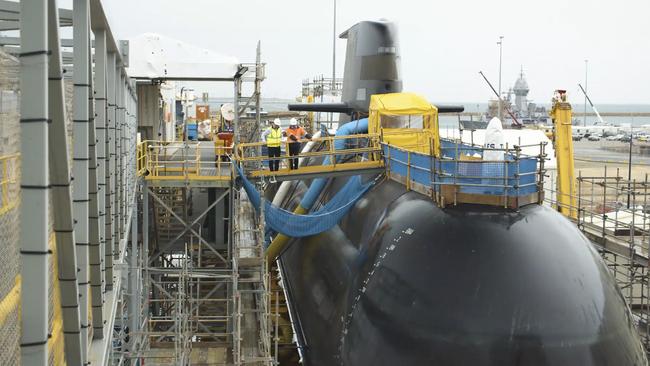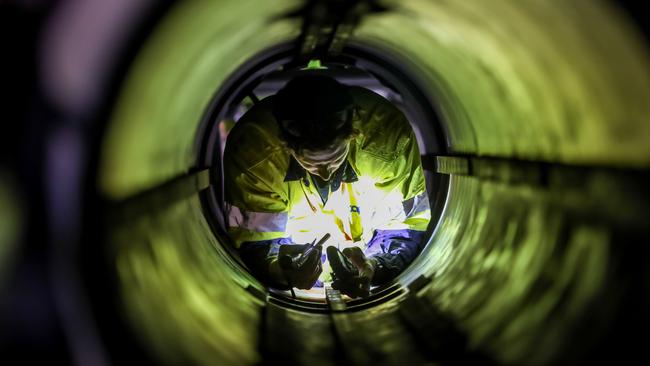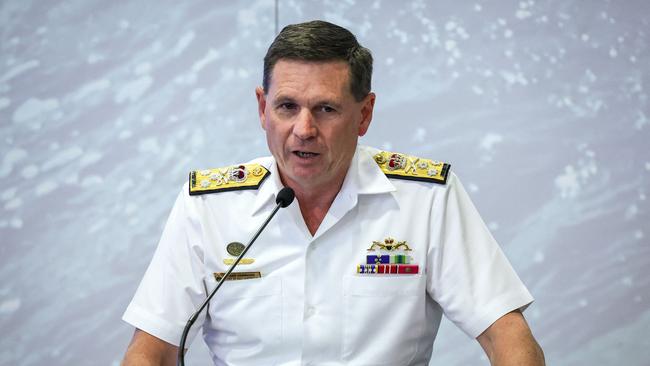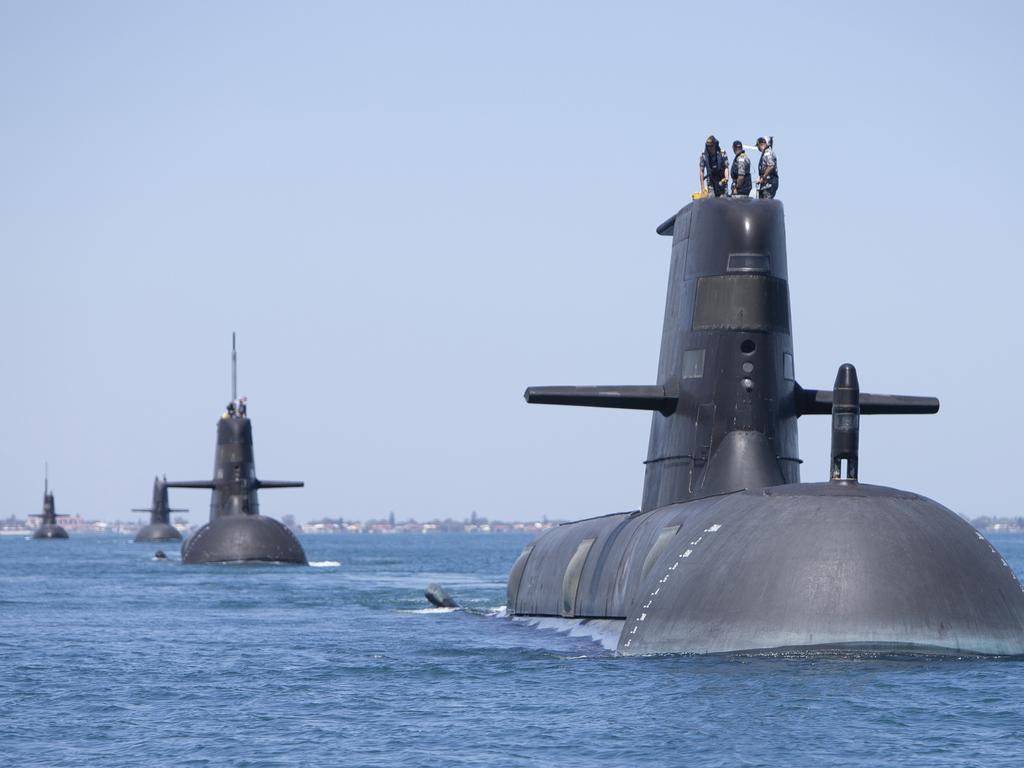Sub par: Collins-class farce with five boats out of water
Only one of the nation’s ageing Collins-class submarines is currently operational in a critical blow to national security.

Only one of the nation’s ageing Collins-class submarines is currently operational in a critical blow to national security, as corrosion problems, maintenance delays and long-running industrial action wreak havoc on the fleet’s availability.
Five of the six boats are out of action and there are now serious questions over the navy’s ability to extend the life of the fleet by a further ten years to bridge a looming capability gap before Australia’s nuclear submarine’s arrive.
The Australian can also reveal the Collins boats, which are approaching the end of their original 30-year lifespans, are now being used more lightly when they are available under a deliberate strategy to avoid unnecessary wear and tear.
One of the submarines, HMAS Sheean, has been stuck in maintenance at Adelaide’s Osborne yard for more than two years with unprecedented corrosion issues, while a second, HMAS Rankin, has been tied up at Osborne for at least five months awaiting upgrades.
Three of the boats - HMAS Farncomb and two others which The Australian is not naming for security reasons - are undergoing or about to undergo maintenance work at Perth’s Henderson precinct.
The remaining Collins boat, which The Australian is also not naming to preserve its operational security, has recently been deployed on exercises and is available for tasking.
It’s understood one of the boats at Henderson is due to exit maintenance in coming weeks, and could re-enter service soon subject to official clearances. Defence insists another of the boats could be pulled from scheduled maintenance in an emergency.
An industrial dispute between unions and the government’s submarine maintenance corporation ASC has exacerbated the problems, setting back work on HMAS Sheean and preventing HMAS Rankin from being lifted from the water.
The Australian Manufacturing Workers Union is leading a campaign to boost South Australian ASC workers’ pay by 18.5 per cent to match rates paid by ASC in Western Australia to keep workers from jumping to the mining sector.

Chief of Navy Mark Hammond said the dispute and its ensuing delays was likely to set back $5bn in “life of type extension” upgrades, due from 2026, by at least six months.
Vice Admiral Hammond said he was unable to confirm that all of the boats would have their lives extended for a decade, as originally planned.
“I’m going to work through that one boat at a time, because we’re talking about platforms that operate hundreds of metres under the water. So I won’t speculate about what the material state might be, boat by boat,” he told The Australian.
He said the scope of the LOTE works was yet to be locked down and was likely to be different for each boat.
Farncomb is the first boat scheduled for the LOTE upgrade. It is one of the one of the oldest submarines in the fleet, and was revealed in May to be suffering serious corrosion in different areas to HMAS Sheean, which has rust in its weapons and exhaust areas.
“I’m expecting to find age-related corrosion issues on each of the boats as they go through. Each one will be subject to a bespoke conditions-based assessment when they go into maintenance, and we will learn the lessons from each previous activity,” Vice Admiral Hammond said.
He said despite the submarines’ age, they were in relatively good condition.
“They’ve been well used, but they’ve also been well cared for throughout their lives. They are still high-end, highly-capable, lethal submarines,” he said.

But The Australian has learned the navy is limiting its use of the boats to try and keep them going for as long as possible. This was a major consideration in its decision not to send one of the submarines to RIMPAC 2024, the US’s biggest military exercise off Hawaii.
Australia has typically sent a submarine to the biennial war games but dramatically scaled-back its contribution to this year’s exercise in July, sending only a single warship and a P-8A maritime reconnaissance aircraft.
The latest submarine availability crunch comes as British defence giant BAE Systems and the government remain tight-lipped over the extent of the damage caused by a fire this week at the company’s shipyard in northern England, which analysts believe could setback the delivery of Australia’s AUKUS-class nuclear boats.
BAE will design and build AUKUS submarines for the UK and Australia, but its capacity to meet the program’s ambitious timelines has already been questioned due to serious capacity constraints at its UK operation.
Opposition defence spokesman Andrew Hastie said he was alarmed to hear five of the Collins boats were “sitting in the workshop, unavailable to defend our sea lanes and approaches”.
“This is a result of the Albanese government’s complete collapse in mismanagement of defence and national security,” Mr Hastie said.

Former naval officer Jennifer Parker, an adjunct naval studies fellow at UNSW Canberra, said the problems now arising with the fleet were inevitable given the failure of successive governments to plan for their replacement.
“The boats are old. It was always going to be a challenge having their life extended,” she said.
“There’s been a lot of effort put into it, but the fact is, they are small conventional submarines that were built to do coastal stuff, and that is not how we’ve operated them.”
Former senator and retired submariner Rex Patrick said the problems with the boats would get worse, and even after the LOTE upgrades they would be no match for modern submarines.
“Yes, some of the major equipment will be modernised, but there’s a lot of other equipment just waiting to fail,“ Mr Patrick said.
“And even if all goes well with the life extension, we’ll be asking our submariners to take a Collins submarine into the South China Sea, which will be the equivalent of asking them to take a pre-World War I submarine into a battle at the end of World War II.”
He said boats’ lack of availability meant they were also unable to undertake vital peacetime work, including intelligence gathering and covert monitoring of foreign military activity.






To join the conversation, please log in. Don't have an account? Register
Join the conversation, you are commenting as Logout